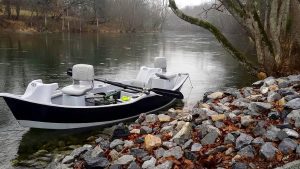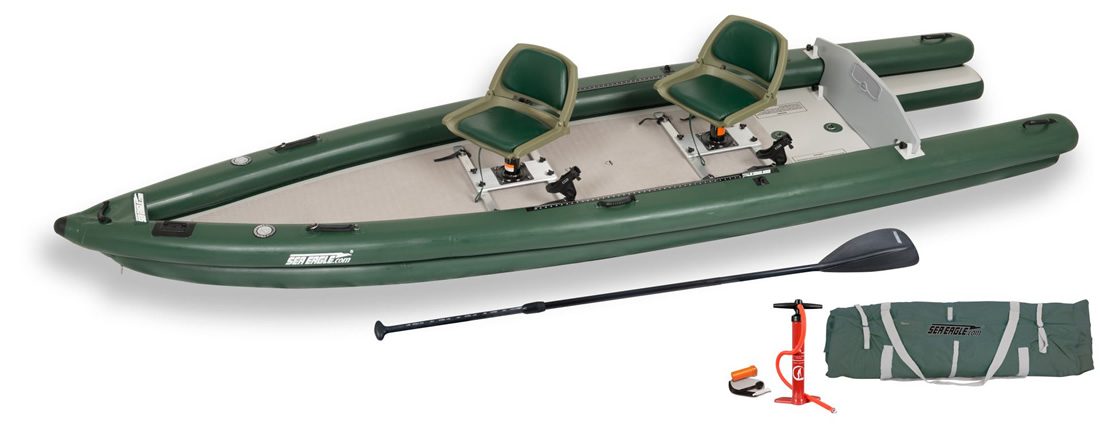Drift boats are truly the ultimate in fly fishing boats. For the angler who wants a boat that is designed for fly fishing and that can handle up to Class III whitewater, a drift boat is the way to go. Outside of Montana and other prime Rocky Mountain/Pacific Northwest/Canadian fishing areas drift boats are rarely seen. And the reason is simple, really. Drift boats were designed for one thing – fly fishing the big Western rivers.

An RO Drift Boat. Image courtesy of RO Drift Boats in Bozeman, MT.
In terms of pure fly fishing ability, a drift boat is the best boat available. A drift boat is extremely maneuverable, roomy and allows an angler to easily stand while fishing. It’s ability to handle moderate whitewater gives it great flexibility in what waters it can be used in, something most pontoon boats lack.
Drift boats are also very expensive. Even a cheap one costs around $3000 and that’s without the trailer. They also lack the versatility of their inflatable counterparts. Still, if an angler wants a boat for one thing only – fishing the rivers out West – and can live with the boats drawbacks, a drift boat is a great choice.
Benefits and Drawbacks of Using Drift Boats
Fishing: For the dedicated fly fisherman who can live with its drawbacks, a drift boat is the boat of choice. They are easy to stand in and very comfortable. They can carry lots of gear and/or people. They are also easy to cast from. Remember, drift boats were designed specifically for fly fishing.
Paddling: As drift boats have a V hull, they are very easy to row. Indeed, they are designed for rowing. They are excellent for rowing over long stretches of slack water or for maneuvering into position on a river.
Maneuverability: Due to its excellent paddling abilities, drift boats are very maneuverable once you get good at paddling.
Durability: A good drift boat is made of quality wood and is very durable. While they may not withstand a sideways, high-speed collision with a rock in whitewater, they are almost as durable as a quality raft. Since these are solid boats (not inflatable), you also do not have to worry about leaks. On the other hand, they are not easy to repair, either, should a crack in the boats aluminum or wood develop.
Portability: Drift boats can only be portaged by trailer. Drift boats generally are large and weigh several hundred pounds. If you don’t have a trailer or don’t want to cart around a boat on a trailer, a drift boat is not the boat for you.
Versatility: Drift Boats were designed for fishing. However, they are also very good boats for recreational floating in waters up to Class III whitewater. While not as fun as an inflatable kayak, drift boats still make good boats for lazy and scenic floats. Since drift boats need a boat ramp of some kind to be easily launched, they are limited to where they can be put into/taken out of the water.
Draft: Drift Boats are not the best boats to use in low water conditions. They draw more water than a inflatable kayak or inflatable raft and are much more susceptible to running aground on a gravel or sand bar.
Affordability: A quality drift boat will run cost, at rock bottom, about $3000. High quality drift boats, with lots of features, easily cost double this amount. Moreover, this cost doesn’t include the required trailer, either.
Where to Find Drift Boats
You generally just don’t “buy” a drift boat online. Instead, you usually visit the various manufacturers of drift boats or the occasional retailer that happens to re-sell them. Listed below are some drift boat manufacturers where you can go to get more information about these boats. Additionally, it is also possible to just buy the “kit” for the driftboat, where you assemble the boat yourself. You’ll save money that way but be sure you are a handy person – messing up the building of a drift boat kit is a sure-fire way to be out lots of money.
- Montana River Boats
- Hyde Drift Boats
- ClackaCraft Drift Boats
- Don Hill River Boats
- Willie Boats
- RO Drift Boats
- Greg Tatman Wooden Boats
- Koffler Drift Boats
- Adipose Drift Boats
- Pavati Marine
- Hog Island Drift Boats
A “Sort Of” Replacement for a Drift Boat
Two of the biggest drawbacks about drift boats are their size and weight. They require a trailer and a boat ramp to use these otherwise fine boats.
And admittedly, the expense of a quality drift boat probably doesn’t help either.
Well, for those seeking a large fishing boat that is still portable, Sea Eagle recently released what they call the “Fishing Skiff.”

Sea Eagle Fishing Skiff 16. Drop stitch construction with a high PSI makes boat very rigid. See more info about the Fishing Skiff at Sea Eagle.Com
As can be seen in the photo, it’s no drift boat. Yet, many drift boats these days are in fact “skiffs.” There’s a number of differences between a “skiff” and a “drift boat,” but one of the biggest is that skiffs are designed to operate in just a couple of inches of water. The downside is that skiffs aren’t meant for whitewater use. They’ll handle fine in Class I and Class II rapids, but they aren’t something you want to use for Class III rapids or above.
And that’s where this Sea Eagle Fishing Skiff comes into play. It draws just a few inches of water, yet it packs down and fits into a trunk. The boat only weighs 100lb compared to triple the weight (or more) for a typical skiff or drift boat. And like other skiffs and drift boats, a motor can be attached to the boat that allows for speeds up to 17mph.
Finally, the Sea Eagle skiff has a hulking weight capacity. Although only designed for two anglers, it’s weight capacity is well over 1000lbs. This allows for massive amounts of gear to be loaded onto the boat. And the 100% drop-stitch construction makes the boat incredibly durable and tough.
Ultimately, the Sea Eagle Fishing Skiff isn’t a “drift boat replacement.” But it is an intriguing option for anglers who desire a large boat for flat waters or sedate rivers and lack the pocketbook/trailer/storage space for a drift boat.

